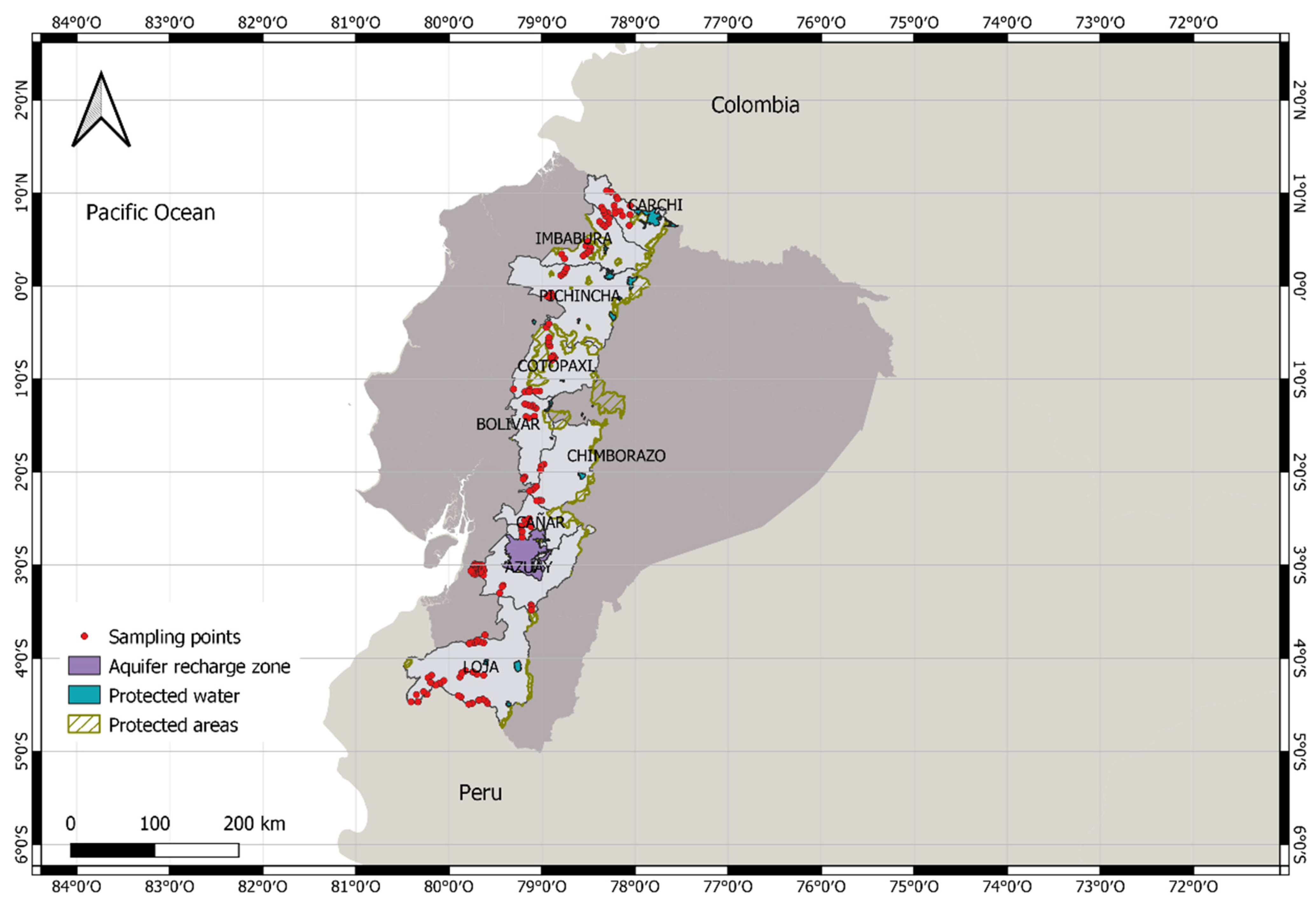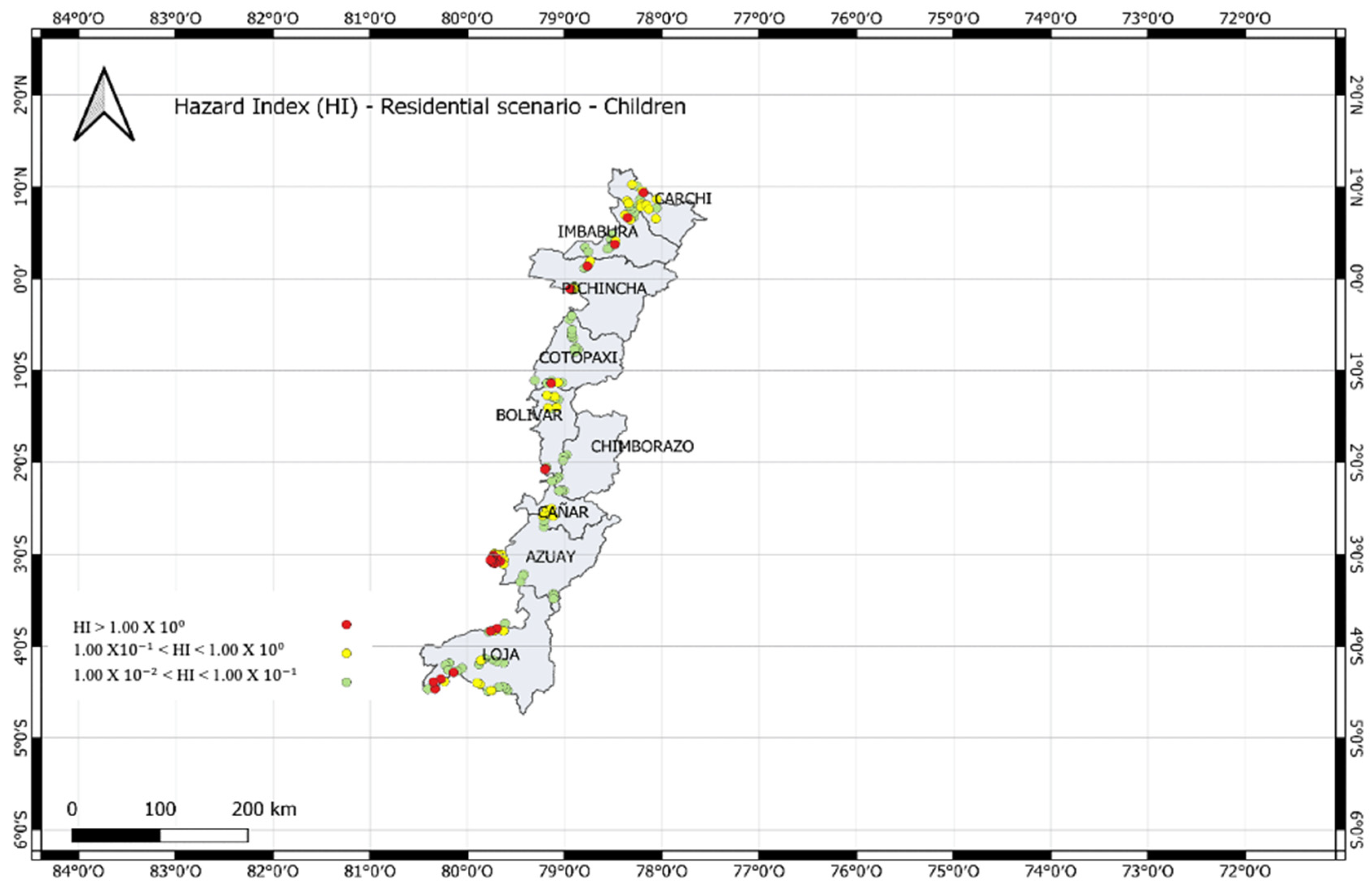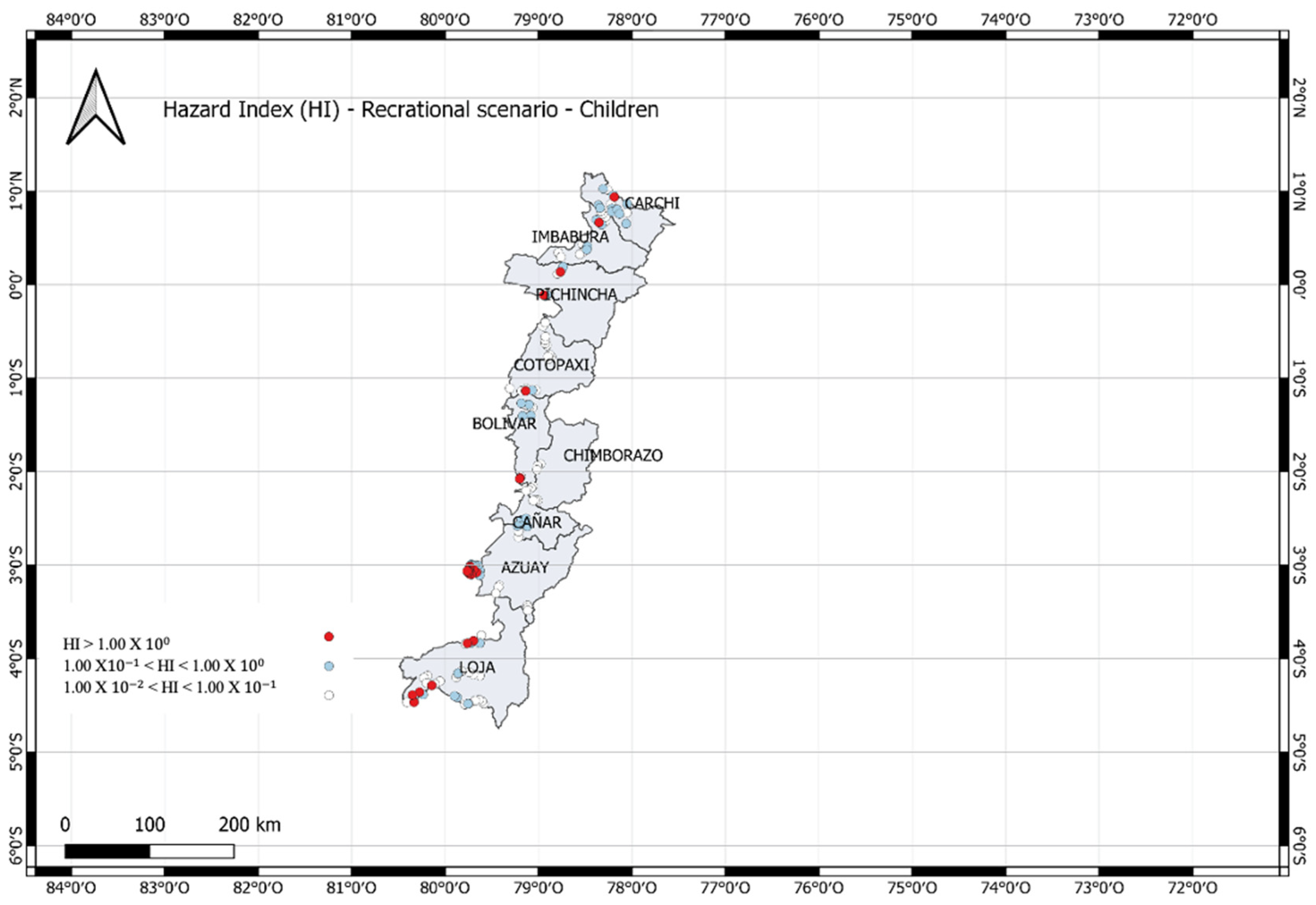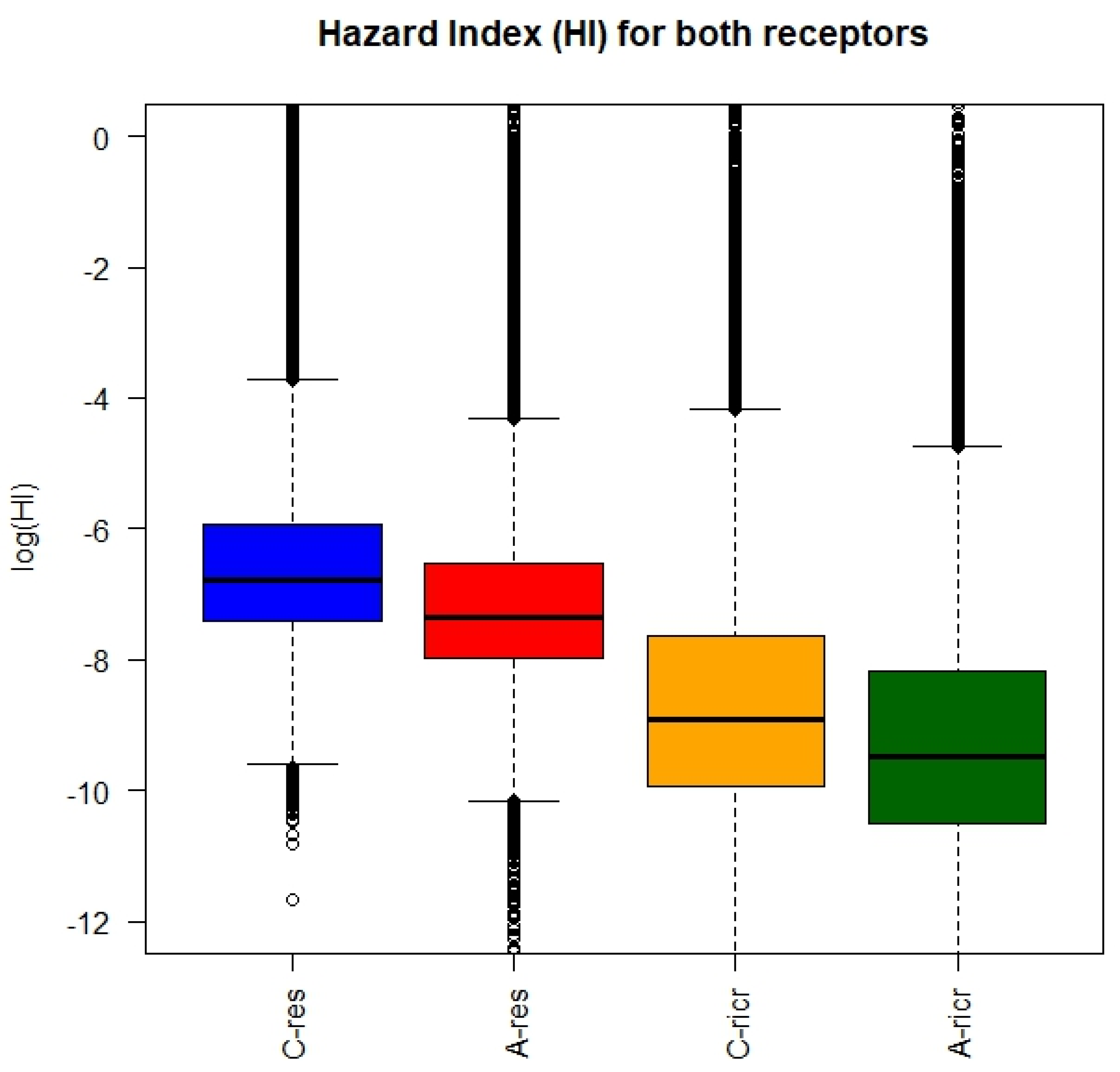Hg Pollution in Groundwater of Andean Region of Ecuador and Human Health Risk Assessment
Abstract
:1. Introduction
2. Materials and Methods
2.1. Study Area
2.2. Sampling and Laboratory Analysis
2.3. Risk Assessment and Characterization
- Equation (1)—Average daily dose by the route of ingestion, USEPA 2001
- Equation (2)—Average daily dose by the route of dermal contact, USEPA 2004
2.3.1. Insight into the Significance of Parameters
- CGW (Concentration) represents the concentration of Hg measured at the selected sampling points;
- Exposure Frequency (EF): This parameter indicates the average number of days per year that the receptor is assumed to be exposed to contamination. Thus, EF varies depending on the specific scenario;
- Ingestion Rate (IR) signifies the average daily amount of contaminated water ingested by the receptor. This quantity fluctuates based on both the scenario and the receptor type;
- Exposure Time (ET): This denotes the duration of exposure relative to the contamination event experienced by the individual. Its value is scenario-dependent;
- Exposure Duration (ED) represents the number of years, on average, during which the receptor is considered to be exposed to contamination. Consequently, the ED value varies depending on the receptor type: adult or child;
- Skin Area (SA): This refers to the average skin area exposed to contamination through dermal contact, varying based on the receptor type;
- Skin Permeability Constant (Kp) indicates the amount of contaminant absorbed per centimeter of exposed skin per hour;
- Averaging Time (AT): This parameter represents the period over which exposure is averaged. Its value differs depending on whether toxic (non-carcinogenic) or carcinogenic substances are being assessed. For toxic substances such as Hg, it is conventionally assumed that AT aligns with ED;
- Body Weight (BW) signifies the average body weight of the receptor and thus varies accordingly;
- Chronic Reference Dose (RfD): This represents the maximum dose of toxic contaminant considered acceptable. Essentially, it is the concentration value of the pollutant for which no adverse health effects have been documented in the literature. Specifically, for the purposes of this analysis, reference was made to RfD values for elemental mercury (metallic). In reality, the reference dose (RfD) is the result of a rough estimate and may have an uncertainty of up to an order of magnitude. The value of the reference dose (RfD) is decisive for the outcome of the analysis results. The reference dose (RfD) is usually determined, for different compounds and exposure modes according to the following equation:
- NOAEL stands for “No Observed Adverse Effect Level”, and among several possible values, the most conservative one is chosen. In the absence of the NOAEL, the LOAEL is used;
- UF is the uncertainty factor;
- MF is the modifying factor. This section may be divided by subheadings. It should provide a concise and precise description of the experimental results, their interpretation, as well as the experimental conclusions that can be drawn;
- For the purpose of this analysis, the EPA-recommended values were used for all the parameters indicated [23].
2.3.2. Calculation of Hazard Quotient (HQ) and Hazard Index (HI)
- Equation (3)—Hazard Quotient (HQ)
3. Results
3.1. Mercury (Hg) Accumulation in Groundwater
3.2. Harm to People’s Wellbeing
3.2.1. Spontaneous Perspective
3.2.2. Probability Perspective
4. Discussion
5. Conclusions
Author Contributions
Funding
Data Availability Statement
Conflicts of Interest
References
- Mestanza-Ramón, C.; Cuenca-Cumbicus, J.; D’Orio, G.; Flores-Toala, J.; Segovia-Cáceres, S.; Bonilla-Bonilla, A.; Straface, S. Gold Mining in the Amazon Region of Ecuador: History and a Review of Its Socio-Environmental Impacts. Land 2022, 11, 221. [Google Scholar] [CrossRef]
- Mestanza-Ramón, C.; Ordoñez-Alcivar, R.; Arguello-Guadalupe, C.; Carrera-Silva, K.; D’Orio, G.; Straface, S. History, Socioeconomic Problems and Environmental Impacts of Gold Mining in the Andean Region of Ecuador. Int. J. Environ. Res. Public Health 2022, 19, 1190. [Google Scholar] [CrossRef] [PubMed]
- Lalander, R.; Eguiguren-Riofrío, M.B.; Vera, A.K.; Espinosa, G.; Reyes, M.; Lembke, M. Indigenous Gold Mining in the Kenkuim Shuar Community: A Decolonial and Postcapitalist Approach to Sustainability. Rev. Iberoam. Estud. Desarro. Iberoam. J. Dev. Stud. 2021, 10, 178–202. [Google Scholar] [CrossRef]
- Svampa, M.; Bottaro, L.; Sola Álvarez, M. La Problemática de La Minería Metalífera a Cielo Abierto: Modelo de Desarrollo, Territorio y Discursos Dominantes; Universidad Nacional de La Plata: La Plata, Argentina, 2009. [Google Scholar]
- Carvalho, P.C.S.; Neiva, A.M.R.; Silva, M.; Santos, A.C.T. Human Health Risks in an Old Gold Mining Area with Circum-Neutral Drainage, Central Portugal. Environ. Geochem. Health 2017, 39, 43–62. [Google Scholar] [CrossRef] [PubMed]
- González-Vicente, R. Development Dynamics of Chinese Resource-Based Investment in Peru and Ecuador. Lat. Am. Polit. Soc. 2013, 55, 46–72. [Google Scholar] [CrossRef]
- Niane, B.; Guédron, S.; Feder, F.; Legros, S.; Ngom, P.M.; Moritz, R. Impact of Recent Artisanal Small-Scale Gold Mining in Senegal: Mercury and Methylmercury Contamination of Terrestrial and Aquatic Ecosystems. Sci. Total Environ. 2019, 669, 185–193. [Google Scholar] [CrossRef] [PubMed]
- Mestanza-Ramón, C.; Mora-Silva, D.; D’Orio, G.; Tapia-Segarra, E.; Gaibor, I.D.; Esparza Parra, J.F.; Chávez Velásquez, C.R.; Straface, S. Artisanal and Small-Scale Gold Mining (ASGM): Management and Socioenvironmental Impacts in the Northern Amazon of Ecuador. Sustainability 2022, 14, 6854. [Google Scholar] [CrossRef]
- EPA/600/8-85/010; Development a Statistical Distributions or Ranges of Standard Factors Used in Exposure Assessments. Environmental Protection Agency: Washington, DC, USA, 1985.
- Teaf, C.M.; Garber, M. Mercury Exposure Considerations: Evaluating the Chemical Form and Activities of the Individual. In Proceedings of the Annual International Conference on Soils, Sediments, Water and Energy, Amherst, MA, USA, 15–18 October 2012; Volume 17, p. 5. [Google Scholar]
- Dooyema, C.A.; Neri, A.; Lo, Y.-C.; Durant, J.; Dargan, P.I.; Swarthout, T.; Biya, O.; Gidado, S.O.; Haladu, S.; Sani-Gwarzo, N. Outbreak of Fatal Childhood Lead Poisoning Related to Artisanal Gold Mining in Northwestern Nigeria, 2010. Environ. Health Perspect. 2012, 120, 601–607. [Google Scholar] [CrossRef] [PubMed]
- Davidson, S.C.; Banfield, A.F. Geology of the Beattie Gold Mine, Duparquet, Quebec. Econ. Geol. 1944, 39, 535–556. [Google Scholar] [CrossRef]
- Fuentes-Gandara, F.; Herrera-Herrera, C.; Pinedo-Hernández, J.; Marrugo-Negrete, J.; Díez, S. Assessment of Human Health Risk Associated with Methylmercury in the Imported Fish Marketed in the Caribbean. Environ. Res. 2018, 165, 324–329. [Google Scholar] [CrossRef] [PubMed]
- Risk Assessment Information System RAIS. Available online: https://rais.ornl.gov/ (accessed on 12 October 2020).
- Jiménez-Oyola, S.; García-Martínez, M.-J.; Ortega, M.F.; Chavez, E.; Romero, P.; García-Garizabal, I.; Bolonio, D. Ecological and Probabilistic Human Health Risk Assessment of Heavy Metal (Loid) s in River Sediments Affected by Mining Activities in Ecuador. Environ. Geochem. Health 2021, 43, 4459–4474. [Google Scholar] [CrossRef] [PubMed]
- Mestanza-Ramón, C.; Jiménez-Oyola, S.; Montoya, A.V.G.; Vizuete, D.D.C.; D’Orio, G.; Cedeño-Laje, J.; Straface, S. Assessment of Hg Pollution in Stream Waters and Human Health Risk in Areas Impacted by Mining Activities in the Ecuadorian Amazon. Environ. Geochem. Health 2023, 10, 7183–7197. [Google Scholar] [CrossRef]
- Avcı, D.; Fernández-Salvador, C. Territorial Dynamics and Local Resistance: Two Mining Conflicts in Ecuador Compared. Extr. Ind. Soc. 2016, 3, 912–921. [Google Scholar] [CrossRef]
- Winckell, A. Relieve Y Geomorfologia Del Ecuador; Centro Ecuatoriano de Investigacion Geografica Guayaquil: Guayaquil, Ecuador, 1982. [Google Scholar]
- Environmental Protection Agency. EPA METHOD 3015A. Available online: https://www.epa.gov/sites/default/files/2015-12/documents/3015a.pdf (accessed on 15 May 2024).
- U.S. Environmental Protection Agency. EPA Method 7473 (SW-846): Mercury in Solids and Solutions by Thermal Decompostion, Amalgamation, and Atomic Absorption Spectrophotometry; U.S. Environmental Protection Agency: Washington, DC, USA, 2011.
- Mestanza-Ramón, C.; Jiménez-Oyola, S.; Gavilanes Montoya, A.V.; Vizuete, D.D.C.; D’Orio, G.; Cedeño-Laje, J.; Urdánigo, D.; Straface, S. Human health risk assessment due to mercury use in gold mining areas in the Ecuadorian Andean region. Chemosphere 2023, 344, 140351. [Google Scholar] [CrossRef] [PubMed]
- Epa, U. Integrated Risk Information System Division. I. Chronic Health Hazard Assessments for Noncarcinogenic Effects I.A. Reference Dose for Chronic Oral Exposure (RfD); U.S. Environmental Protection Agency: Washington, DC, USA, 1987.
- R Core Team. A Language and Environment for Statistical Computing; R Foundation for Statistical Computing: Vienna, Austria, 2023; Available online: https://www.R-project.org/ (accessed on 15 May 2024).
- Jiménez-Oyola, S.; Chavez, E.; García-Martínez, M.-J.; Ortega, M.F.; Bolonio, D.; Guzmán-Martínez, F.; García-Garizabal, I.; Romero, P. Probabilistic Multi-Pathway Human Health Risk Assessment Due to Heavy Metal(Loid)s in a Traditional Gold Mining Area in Ecuador. Ecotoxicol. Environ. Saf. 2021, 224, 112629. [Google Scholar] [CrossRef]
- Chen, G.; Wang, X.; Liu, G. Health risk assessment of potential harmful elements in subsidence water bodies using a Monte Carlo approach: An exemple from the Huainan coal mining area. Ecotoxicol. Environ. Saf. 2019, 171, 737–745. [Google Scholar] [CrossRef]
- World Health Organization (WHO). Exposure to Mercury: A Major Public Health Concern, 2nd ed.; WHO: Geneva, Switzerland, 2021; Available online: https://www.who.int/publications/i/item/9789240023567 (accessed on 15 May 2024).
- Oakley, P. Making Mercury’s Histories: Mercury in Gold Mining’s Past and Present. ambix 2023, 20, 77–98. [Google Scholar] [CrossRef] [PubMed]
- Althomali, R.H.; Abbood, M.A.; Saleh, E.A.M.; Djuraeva, L.; Abdullaeva, B.S.; Habash, R.T.; Alhassan, M.S.; Alawady, A.H.R.; Alsaalamy, A.H.; Najafi, M.L. Exposure to heavy metals and neurocognitive function in adults: A systematic review. Environ. Sci. Eur. 2024, 36, 18. [Google Scholar] [CrossRef]
- Kim, J.H.; Na, J.E.; Lee, J.; Park, Y.E.; Lee, J.; Choi, J.H.; Heo, N.Y.; Park, J.; Kim, T.O.; Jang, H.J.; et al. Blood Concentrations of Lead, Cadmium, and Mercury Are Associated With Alcohol-Related Liver Disease. J. Korean Med. Sci. 2023, 38, e412. [Google Scholar] [CrossRef] [PubMed]
- Anderson, E.; Browne, N.; Duletsky, S.; Raming, J.; Warn, T. Development of Statistical Distributions or Ranges of Standard Factors Used in Exposure Assessments 1985, 59. Available online: https://nepis.epa.gov/Exe/ZyPDF.cgi/91007IEM.PDF?Dockey=91007IEM.PDF (accessed on 12 March 2024).
- Budnik, L.T.; Casteleyn, L. Mercury Pollution in Modern Times and Its Socio-Medical Consequences. Sci. Total Environ. 2019, 654, 720–734. [Google Scholar] [CrossRef] [PubMed]









| Parameter | Point Value |
|---|---|
| EFresidential (day/year) a | 350 |
| EFrecreational (day/year) a | 120 |
| ETresidential (hour/event) b | 0.22 |
| ETrecreational (hour/event) a | 2.6 |
| IRresidential (L/day) a | A = 2.04; C = 1.28 |
| IRrecreational (L/day) a | A = 0.053; C = 0.090 |
| ED (year) b,d | A = 30; C = 6 |
| SA (cm2) b,e,f | A = 23,000; C = 7280 |
| Bw (kg) e,f | A = 72; C = 15.6 |
| Province | n | Min–Max | p50 | S.D. |
|---|---|---|---|---|
| Charchi | 14 | 0.00025–0.0045 | 0.0011 | 0.00115 |
| Imbabura | 19 | 0.00025–0.0043 | 0.00025 | 0.00115 |
| Pichincha | 11 | 0.00025–0.0043 | 0.0011 | 0.00137 |
| Cotopaxi | 17 | 0.00025–0.0033 | 0.00025 | 0.00087 |
| Bolivar | 16 | 0.00025–0.0041 | 0.00025 | 0.00129 |
| Chimborazo | 6 | * | * | * |
| Cañar | 7 | 0.00025–0.0022 | 0.0011 | 0.00081 |
| Azuay | 46 | 0.00025–0.0089 | 0.0011 | 0.00317 |
| Loja | 39 | 0.00025–0.0089 | 0.00025 | 0.00286 |
| Province | Parameter | Residential Scenario | Recreational Scenario | ||
|---|---|---|---|---|---|
| Adults | Children | Adults | Children | ||
| Charchi | HQ_ingestion | 3.08 × 10−1 | 8.92 × 10−1 | 2.74 × 10−3 | 2.15 × 10−2 |
| HQ_dermal contact | 8.62 × 10−3 | 1.26 × 10−2 | 3.49 × 10−2 | 5.10 × 10−2 | |
| HI | 3.17 × 10−1 | 9.04 × 10−1 | 3.77 × 10−2 | 7.25 × 10−2 | |
| Imbabura | HQ_ingestion | 3.89 × 10−1 | 1.13 × 100 | 2.02 × 10−4 | 1.58 × 10−3 |
| HQ_dermal contact | 3.37 × 10−2 | 4.92 × 10−2 | 1.37 × 10−1 | 1.99 × 10−1 | |
| HI | 4.23 × 10−1 | 1.18 × 100 | 1.37 × 10−1 | 2.01 × 10−1 | |
| Pichincha | HQ_ingestion | 3.44 × 10−1 | 9.97 × 10−1 | 3.07 × 10−3 | 2.40 × 10−2 |
| HQ_dermal contact | 2.98 × 10−2 | 4.35 × 10−2 | 1.21 × 10−1 | 1.76 × 10−1 | |
| HI | 3.74 × 10−1 | 1.04 × 100 | 1.24 × 10−1 | 2.00 × 10−1 | |
| Cotopaxi | HQ_ingestion | 2.54 × 10−1 | 7.34 × 10−1 | 2.26 × 10−3 | 1.77 × 10−2 |
| HQ_dermal contact | 2.19 × 10−2 | 3.21 × 10−2 | 8.89 × 10−2 | 1.30 × 10−1 | |
| HI | 2.76 × 10−1 | 7.66 × 10−1 | 9.12 × 10−2 | 1.48 × 10−1 | |
| Bolivar | HQ_ingestion | 2.90 × 10−1 | 8.39 × 10−1 | 2.58 × 10−3 | 2.02 × 10−2 |
| HQ_dermal contact | 2.51 × 10−2 | 3.66 × 10−2 | 1.02 × 10−1 | 1.48 × 10−1 | |
| HI | 3.15 × 10−1 | 8.76 × 10−1 | 1.04 × 10−1 | 1.69 × 10−1 | |
| Chimborazo | HQ_ingestion | 2.26 × 10−2 | 6.56 × 10−2 | 2.02 × 10−4 | 1.58 × 10−3 |
| HQ_dermal contact | 1.96 × 10−3 | 2.86 × 10−3 | 7.94 × 10−3 | 1.16 × 10−2 | |
| HI | 2.46 × 10−2 | 6.84 × 10−2 | 8.14 × 10−3 | 1.32 × 10−2 | |
| Cañar | HQ_ingestion | 1.99 × 10−1 | 5.77 × 10−1 | 1.77 × 10−3 | 1.39 × 10−2 |
| HQ_dermal contact | 1.72 × 10−2 | 2.52 × 10−2 | 6.99 × 10−2 | 1.02 × 10−1 | |
| HI | 2.16 × 10−1 | 6.02 × 10−1 | 7.16 × 10−2 | 1.16 × 10−1 | |
| Azuay | HQ_ingestion | 7.53 × 100 | 2.18 × 101 | 6.70 × 10−2 | 5.25 × 10−1 |
| HQ_dermal contact | 6.51 × 10−1 | 9.51 × 10−1 | 2.64 × 100 | 3.85 × 100 | |
| HI | 8.18 × 100 | 2.27 × 101 | 2.71 × 100 | 4.38 × 100 | |
| Loja | HQ_ingestion | 6.81 × 100 | 1.97 × 101 | 6.07 × 10−2 | 4.75 × 10−1 |
| HQ_dermal contact | 5.89 × 10−1 | 8.61 × 10−1 | 2.39 × 100 | 3.49 × 100 | |
| HI | 7.40 × 100 | 2.06 × 101 | 2.45 × 100 | 3.96 × 100 | |
| Province | Parameter | Residential Scenario | Recreational Scenario | ||
|---|---|---|---|---|---|
| Adults | Children | Adults | Children | ||
| Charchi | HQ_ingestion | 9.96 × 10−2 | 2.88 × 10−1 | 8.87 × 10−4 | 6.95 × 10−3 |
| HQ_dermal contact | 8.62 × 10−3 | 1.26 × 10−2 | 3.49 × 10−2 | 5.10 × 10−2 | |
| HI | 1.08 × 10−1 | 3.01 × 10−1 | 3.58 × 10−2 | 5.80 × 10−2 | |
| Imbabura | HQ_ingestion | 2.26 × 10−2 | 6.56 × 10−2 | 1.05 × 10−3 | 8.22 × 10−3 |
| HQ_dermal contact | 1.96 × 10−3 | 2.86 × 10−3 | 7.94 × 10−3 | 1.16 × 10−2 | |
| HI | 2.46 × 10−2 | 6.84 × 10−2 | 8.99 × 10−3 | 1.98 × 10−2 | |
| Pichincha | HQ_ingestion | 6.11 × 10−2 | 1.77 × 10−1 | 5.45 × 10−4 | 4.27 × 10−3 |
| HQ_dermal contact | 5.29 × 10−3 | 7.73 × 10−3 | 2.14 × 10−2 | 3.13 × 10−2 | |
| HI | 6.64 × 10−2 | 1.85 × 10−1 | 2.20 × 10−2 | 3.56 × 10−2 | |
| Cotopaxi | HQ_ingestion | 2.26 × 10−2 | 6.56 × 10−2 | 2.02 × 10−4 | 1.58 × 10−3 |
| HQ_dermal contact | 1.96 × 10−3 | 2.86 × 10−3 | 7.94 × 10−3 | 1.16 × 10−2 | |
| HI | 2.46 × 10−2 | 6.84 × 10−2 | 8.14 × 10−3 | 1.32 × 10−2 | |
| Bolivar | HQ_ingestion | 2.26 × 10−2 | 6.56 × 10−2 | 2.02 × 10−4 | 1.58 × 10−3 |
| HQ_dermal contact | 1.96 × 10−3 | 2.86 × 10−3 | 7.94 × 10−3 | 1.16 × 10−2 | |
| HI | 2.46 × 10−2 | 6.84 × 10−2 | 8.14 × 10−3 | 1.32 × 10−2 | |
| Chimborazo | HQ_ingestion | 2.26 × 10−2 | 6.56 × 10−2 | 2.02 × 10−4 | 1.58 × 10−3 |
| HQ_dermal contact | 1.96 × 10−3 | 2.86 × 10−3 | 7.94 × 10−3 | 1.16 × 10−2 | |
| HI | 2.46 × 10−2 | 6.84 × 10−2 | 8.14 × 10−3 | 1.32 × 10−2 | |
| Cañar | HQ_ingestion | 9.06 × 10−2 | 2.62 × 10−1 | 8.07 × 10−4 | 6.32 × 10−3 |
| HQ_dermal contact | 7.84 × 10−3 | 1.14 × 10−2 | 3.18 × 10−2 | 4.64 × 10−2 | |
| HI | 9.84 × 10−2 | 2.74 × 10−1 | 3.26 × 10−2 | 5.27 × 10−2 | |
| Azuay | HQ_ingestion | 9.96 × 10−1 | 2.88 × 100 | 8.87 × 10−3 | 6.95 × 10−2 |
| HQ_dermal contact | 8.62 × 10−2 | 1.26 × 10−1 | 3.49 × 10−1 | 5.10 × 10−1 | |
| HI | 1.08 × 100 | 3.01 × 100 | 3.58 × 10−1 | 5.80 × 10−1 | |
| Loja | HQ_ingestion | 2.26 × 10−1 | 6.56 × 10−1 | 2.02 × 10−3 | 1.58 × 10−2 |
| HQ_dermal contact | 1.96 × 10−2 | 2.86 × 10−2 | 7.94 × 10−2 | 1.16 × 10−1 | |
| HI | 2.46 × 10−1 | 6.84 × 10−1 | 8.14 × 10−2 | 1.32 × 10−1 | |
| Parameter | Units | Point Estimate | Distribution | Reference |
|---|---|---|---|---|
| EFresidential | day/year | 350 | Triangular: 345 (180–365) | a |
| EFrecreational | day/year | Triangular: 120 (26–260) | a | |
| ETresidential | hour/event | 0.22 | a | |
| ETrecreational | hour/event | 2.6 | Triangular: 2.6 (0.5–6) | b |
| IRresidential | L/day | A = 2.04; C = 1.28 | a | |
| IRrecreational | L/day | A = 0.053; C = 0.090 | c | |
| EDadults | year | 30 | Lognormal: 11.36 ± 13.72 | d |
| EDchildren | year | 6 | Uniform: 1–6 | b |
| SAadults | cm2 | 23,000 | Normal: 18,400 ± 2300 | e; f; b |
| SAchildren | cm2 | 7280 | Normal: 6800 ± 600 | |
| BWadults | kg | Normal: 72 ± 15.9 | e; f | |
| BWchildren | kg | 15.6 | Normal: 15.6 ± 3.7 |
Disclaimer/Publisher’s Note: The statements, opinions and data contained in all publications are solely those of the individual author(s) and contributor(s) and not of MDPI and/or the editor(s). MDPI and/or the editor(s) disclaim responsibility for any injury to people or property resulting from any ideas, methods, instructions or products referred to in the content. |
© 2024 by the authors. Licensee MDPI, Basel, Switzerland. This article is an open access article distributed under the terms and conditions of the Creative Commons Attribution (CC BY) license (https://creativecommons.org/licenses/by/4.0/).
Share and Cite
Passarelli, I.; Mora-Silva, D.; Jimenez-Gutierrez, M.; Logroño-Naranjo, S.; Hernández-Allauca, D.; Valdez, R.U.; Avalos Peñafiel, V.G.; Tierra Pérez, L.P.; Sanchez-Salazar, M.; Tobar Ruiz, M.G.; et al. Hg Pollution in Groundwater of Andean Region of Ecuador and Human Health Risk Assessment. Resources 2024, 13, 84. https://doi.org/10.3390/resources13060084
Passarelli I, Mora-Silva D, Jimenez-Gutierrez M, Logroño-Naranjo S, Hernández-Allauca D, Valdez RU, Avalos Peñafiel VG, Tierra Pérez LP, Sanchez-Salazar M, Tobar Ruiz MG, et al. Hg Pollution in Groundwater of Andean Region of Ecuador and Human Health Risk Assessment. Resources. 2024; 13(6):84. https://doi.org/10.3390/resources13060084
Chicago/Turabian StylePassarelli, Irene, Demmy Mora-Silva, Mirian Jimenez-Gutierrez, Santiago Logroño-Naranjo, Damaris Hernández-Allauca, Rogelio Ureta Valdez, Victor Gabriel Avalos Peñafiel, Luis Patricio Tierra Pérez, Marcelo Sanchez-Salazar, María Gabriela Tobar Ruiz, and et al. 2024. "Hg Pollution in Groundwater of Andean Region of Ecuador and Human Health Risk Assessment" Resources 13, no. 6: 84. https://doi.org/10.3390/resources13060084
APA StylePassarelli, I., Mora-Silva, D., Jimenez-Gutierrez, M., Logroño-Naranjo, S., Hernández-Allauca, D., Valdez, R. U., Avalos Peñafiel, V. G., Tierra Pérez, L. P., Sanchez-Salazar, M., Tobar Ruiz, M. G., Carrera-Silva, K., Straface, S., & Mestanza-Ramón, C. (2024). Hg Pollution in Groundwater of Andean Region of Ecuador and Human Health Risk Assessment. Resources, 13(6), 84. https://doi.org/10.3390/resources13060084










